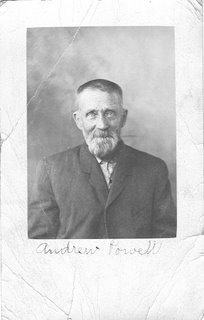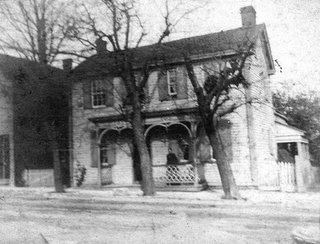 The Reeve Holland house is still standing at
The Reeve Holland house is still standing at
38 North Main Street in Waynesville, Ohio.
It was built in 1836.
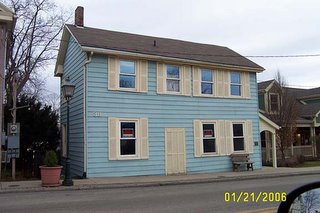
Reeve Holland (January 24, 1808~May 31, 1893) was a carpenter and builder in Waynesville starting in 1835. He was the builder of the first Waynesville Episcopal Church building located on the southeast corner of North & Third Streets in 1840 (no longer extant, see photo below, a new building replaced it in 1915). Reeve and Sarah, his wife, were devoted Methodists and well loved in Waynesville. He retired from active carpentry work in 1863. Reeve Holland was also one of the first subscribers to Miami Cemetery and on the first Board of Trustees holding the office of treasurer of the cemetery.

The 1840 Waynesville Episcopal Methodist Church
Reeve was also a great benefactor to Waynesville. It was reported in the Miami-Gazette on May 3, 1876:
Thanks to Mr. Reeve Holland, the work of completing the two rows of shade trees between the bridges is nearly or perhaps quite accomplished. Mr. Holland procured over 50 trees the other day ~ going 8 miles into the Swamp for them and pays for them and setting them out, out of his private purse.
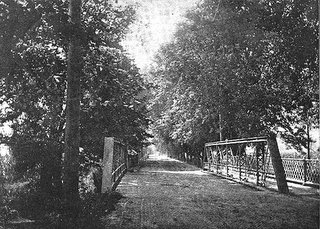
The above refers to Corwin Avenue which crosses from Corwin to Waynesville over the Little Miami River and the mill race.
Reeve was married to Sarah Bowman Holland (February 10, 1812 ~ August 26, 1907) on January 21, 1835. Reeve was one of the six children of James (May 1, 1775 ~ April 20, 1858) and Hannah Reeve Holland (September 10, 1779 ~ December 24, 1863).
James Holland's obituary was published in the Miami-Visitor newspaper on April 28th, 1858:
"DIED. ~ Of brocheal (?) affliction, on the 20th inst., in this place, JAMES HOLLAND, in the eighty-third year of his age. He was born May 1, 1775 in Burlington County, New Jersey, and emigrated to Ohio in 1817. His sickness was of but short duration and he seemed to be sensible that it was his last. He told his son he should not get well, but expressed a willingness with patience and Christian fortitude. Not a murmur fell from his lips. A few hours before he stepped into the cold waters of the Jordan of death, he said,"I am almost home." He was a loving husband, an affectionate father, a kind neighbor, and a humble Christian. Among his numerous surviving relatives, both in the East and West, is his widow ~ the companion of his youth, and comrade for more than fifty years, and six children. May they all meet in Heaven:
Servant of God, well done;
Thy glorious warriors' past;
The battles fought, the race is won;
And thou are crowned at last.
There is a biography of Reeve Holland in the 1882 Warren County History, p. 858:
"REEVE HOLLAND, retired carpenter and builder. Waynesville, was born in New Jersey, Jan. 24, 1808; is a son of James and Hannah (Reeves) Holland, natives of New Jersey. The grandparents were John and Jane Holland, natives of New Jersey; the ancestors being of Scotch-Irish descent. James and family emigrated to Ohio, and located near Waynesville in 1817, being among the early settlers of this county. He was a weaver by trade, and soon after he came here located in Waynesville, where he followed his trade the most of his life; he died in Waynesville about 1857, age 85 years; his wife died about 1861, age 85 years. They had ten children, six now survive ~
Reeve
Franklin
Wesley
Maria (now Mrs. Parker, residing at Camp Dennison)
Ruth Ann (now Mrs. Bodine, residing at Madisonville)
Emiline (now Mrs. Leatcham, residing in Iowa).
The subject of this sketch was but 9 years of age when their family came to this new county, and here he was raised and grew to manhood, fully accustomed to all the rough scenes of those early days; was married January 21, 1835, to Sarah, daughter of Abraham and Ellen Bowman, natives of Virginia, but who emigrated to Kentucky, where they resided till 1817, when they removed to Warren County, and locate near Waynesville, where they lived and ided; they had eleven children, five now survive ~
- John, living in Indiana
- Didema, now Widow Carr, living in Iowa
- Sarah
- Mary Ann, now Mrs. Retallick.
Mr. (Reeve) Holland and wife have had four children, all deceased; the youngest Joel Marshall, grew to manhood and gave promise of becoming a prominent man. During the administration of President Lincoln, he was appointed United States Mail Agent, on the C.C.R.R., which office he filled about one year; thence assumed the duties of the Distributing Department in the Post Office at Cincinnati, where, after a few months' service was prostrated with sickness and returned home, where he died, Sept. 26, 1862, aged about 24 years; his young promising life being thus early cut off.
Mr. (Reeve) Holland when sixteen years of age learned the carpenter trade and became one of the best and most prominent builders of that day; erecting a large number of the buildings in Waynesville and vicinity. In 1863, Mr. Holland retired from all active business, having acquired a good competency. He has resided on the property where he now lives for forty-five years; has erected a good substantial frame house, and has everything comfortable and convenient around him; where he and his companion have lived for almost half a century, and can now enjoy the fruits of their labors under their 'own wine and fig-tree.'"
Two of their children are buried next to Reeve and Sarah Holland in Miami Cemetery, section H (see below). Sarah's obituary only mentions two children. Other references refer to four children.
James and Hannah Holland, Reeve's parents, are also buried in the same family plot.
In 1835, Reeve and Sarah Bowman Holland celebrated their Golden Wedding. A long article in the Miami-Gazette, tells the story of their marriage day. As they were returning from their wedding, which took place on the Thomas Smith farm on Caesar's Creek (Sarah had been adopted into the Smith family), to Waynesville, Reeve received bad news.
"~ during the night the cabinet shop of John Loyd had burned down, and contents destroyed, among which were the carpenter tools of Mr. Holland, which constituted his entire stock in trade. But Mr. Holland says the thought that he possessed a brand new wife inspired him with courage , and he called on friends for help and got it, and to this day remembers gratefully David Evans and Joseph Chapman for their generosity in enabling him to again procure tools, with which he went to work with a will and cheered by the brave spirit of his wife, and seconded in all his efforts by her energy and thrift, he succeeded . . .
Mr. and Mrs. Holland went to house-keeping the Spring following their marriage in a house which occupied the same ground where they now live, and from there they have never moved, but have built and improved until they have all the comforts and conveniences they desire. They have seen their surroundings change from a sugar grove to a well improved town from their front window they now see a block of buildings where they once saw only trees and grass. They have witnessed the transition of their surroundings while they have moved on in the own tenor of their ways, quietly and unobtrusively yet factors in the progress of events. Mr. Holland has been the practical architect of many of the buildings in the town and Corwin and the surrounding country while "Auntie Holland" has been a "ministering angel" at many a bed of sichness and in many scenes of sorrow. . ."
There is a death notice of Sarah Holland's death in the Miami-Gazette on August 28, 1907. A lengthy obituary for "Aunt" Sarah Bowman Holland is found in the Miami-Gazette, August 28, 1907. It includes Rev. Phillip Trout's sermon at her funeral:
DEATH CLAIMS WAYNESVILLE'S OLDEST CITIZEN
AND PERHAPS THE OLDEST PERSON IN
WARREN COUNTY
Sarah Bowman Holland was the daughter of Abram and Eleanor Bowman and was born at Flemingsburg, Kentucky, Feb. 10, 1812 and died at her home on Main Street, Aug. 26th, 1907 at the ripe old age of 95 years, 6 months and 16 days. When but a child she moved with her parents to Ohio and settled near Waynesville, on the Hall farm, now known as the O'Neall place. She was one of a family of ten children; all are now dead except one sister, Amelia Rogers, of Harveysburg, Ohio.
She was married to Reeve Holland, Jan. 21st, 1835 and went to housekeeping in a small house on Main Street, where they lived for a few weeks only, when Mr. Holland purchased the present home (in an unfinished condition.) They immediately moved into it and it has been her home from that day until the day of her death, a period of more than 72 years, and with her death the oldest home in Waynesville is broken up.
To Mr. & Mrs. Holland there were born two sons. "Together they mourned the loss of their first born Samuel Bowman, who died in 1837 a little less than 18 months old. Their second son Joel Marshall lived to comfort them and honor himself by an upright useful career of nearly 25 years, when he too passed to the great Beyond." The death of this son in the prime of his manhood was a great affliction but it was born with grace and patience.
Sister Holland united with the Waynesville Methodist Episcopal Church in the year 1836 under the pastorate of Rev. Wm. Sutton, and has been one of its most faithful and honored members to the time of her death being the church's oldest member having a continued membership for more than 70 years. For many years the prayer meetings of the Society were held in her home; also the class meeting, and once the Quarterly Conference of the Circuit was held in her home. In those early days the Quarterly Meeting brought men and women by the score from a distance to be entertained for two days or more. Her home was open to all, her hospitality knew no bounds. Many were made welcome and there were many times when as many as 30 or 35 persons were kept overnight. In those early days of large Circuits, when the preacher was away from his home most of the time, he always found welcome at her home, and for many years her home was the home of her pastor. Many of the early preachers of Methodism who afterward famous for their ability and preaching power, were entertained by her.
She has held a large place in this community for many years. she was a neighbor of the old type, ever ready to help to visit and care for the sick and all who were in distress. She was good to the poor and gave much to their relief. A long and noble life has closed. Her faithfulness to the church, her care for the sick, and her love for her fellows is something to be remembered and cherished by all who knew her. She had outlived her generation and was ready and waiting the coming of God's Chariot to take her Spirit home, and now that she has gone from us we can but say, 'The Lord gave and the Lord has taken away, blessed be the name of the Lord'. 'We shall meet again in the morning'. ~ Phillip Trout, Pastor.
The funeral of Mrs. Holland was held from her later residence Thursday afternoon at 1 o'clock conducted by Phillip Trout, her pastor, and Rev. Wm. Coffman of Sabina, a former pastor, and was attended by a large number of friends and relatives. Mrs. Holland will be greatly missed and although, she had lived to be almost a centenarian, her faculties were unusually acute and she took pride in being 'up and doing' so long as strength was given her. The body was laid to rest in Miami Cemetery to await the call on the last great day.
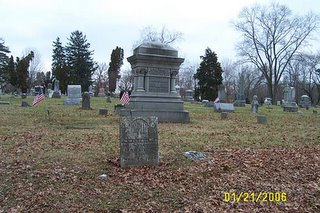
Holland Grave Plot in Miami Cemetery ~ Corwin, Ohio
Foreground ~ graves of James and Hannah Reeve Holland
Holland Grave Plot ~
Foreground ~Reeve and Sarah Bowman Holland







